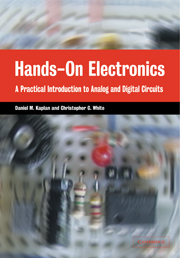Book contents
- Frontmatter
- Contents
- List of figures
- List of tables
- About the authors
- To the Reader
- Acknowledgments
- Introduction
- 1 Equipment familiarization: multimeter, breadboard, and oscilloscope
- 2 RC circuits
- 3 Diodes
- 4 Bipolar transistors
- 5 Transistors II: FETs
- 6 Transistors III: differential amplifier
- 7 Introduction to operational amplifiers
- 8 More op amp applications
- 9 Comparators and oscillators
- 10 Combinational logic
- 11 Flip-flops: saving a logic state
- 12 Monostables, counters, multiplexers, and RAM
- 13 Digital↔analog conversion
- Further reading
- Appendix A Equipment and supplies
- Appendix B Common abbreviations and circuit symbols
- Appendix C RC circuits: frequency-domain analysis
- Appendix D Pinouts
- Glossary of basic electrical and electronic terms
- Index
1 - Equipment familiarization: multimeter, breadboard, and oscilloscope
Published online by Cambridge University Press: 06 July 2010
- Frontmatter
- Contents
- List of figures
- List of tables
- About the authors
- To the Reader
- Acknowledgments
- Introduction
- 1 Equipment familiarization: multimeter, breadboard, and oscilloscope
- 2 RC circuits
- 3 Diodes
- 4 Bipolar transistors
- 5 Transistors II: FETs
- 6 Transistors III: differential amplifier
- 7 Introduction to operational amplifiers
- 8 More op amp applications
- 9 Comparators and oscillators
- 10 Combinational logic
- 11 Flip-flops: saving a logic state
- 12 Monostables, counters, multiplexers, and RAM
- 13 Digital↔analog conversion
- Further reading
- Appendix A Equipment and supplies
- Appendix B Common abbreviations and circuit symbols
- Appendix C RC circuits: frequency-domain analysis
- Appendix D Pinouts
- Glossary of basic electrical and electronic terms
- Index
Summary
In this chapter you will become acquainted with the ‘workhorses’ of electronics testing and prototyping: multimeters, breadboards, and oscilloscopes. You will find these to be indispensable aids both in learning about and in doing electronics.
Apparatus required
One dual-trace oscilloscope, one powered breadboard, one digital multimeter, two 10X attenuating scope probes, red and black banana leads, two alligator clips.
Multimeter
You are probably already familiar with multimeters. They allow measurement of voltage, current, and resistance. Just as with wristwatches and clocks, in recent years digital meters (commonly abbreviated to DMM for digital multimeter or DVM for digital voltmeter) have superseded the analog meters that were used for the first century and a half or so of electrical work. The multimeters we use have various input jacks that accept ‘banana’ plugs, and you can connect the meter to the circuit under test using two banana-plug leads. The input jacks are described in Table 1.1. Depending on how you configure the meter and its leads, it displays
the voltage difference between the two leads,
the current flowing through the meter from one lead to the other, or
the resistance connected between the leads.
Multimeters usually have a selector knob that allows you to select what is to be measured and to set the full-scale range of the display to handle inputs of various size. Note: to obtain the highest measurement precision, set the knob to the lowest setting for which the input does not cause overflow.
- Type
- Chapter
- Information
- Hands-On ElectronicsA Practical Introduction to Analog and Digital Circuits, pp. 1 - 14Publisher: Cambridge University PressPrint publication year: 2003



